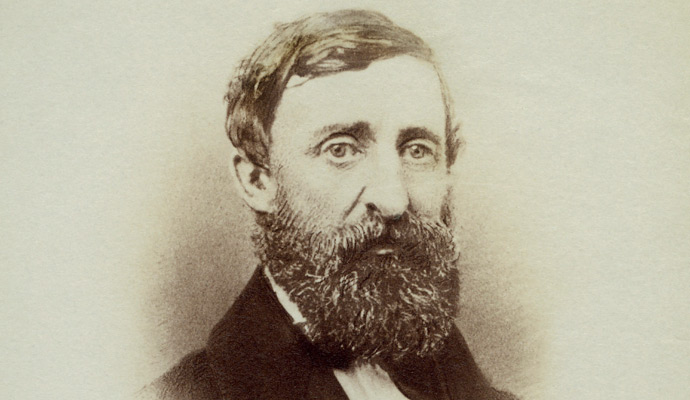Yes, Henry David Thoreau Was an Industrial Innovator
We can learn valuable lessons from the transcendentalist writer’s forays into the family pencil business.
Henry David Thoreau, the 19th-century writer, philosopher, and naturalist, is probably best known for having holed up in a cabin by Walden Pond to escape the pressures of the commercial and material world. But far fewer people know that Thoreau’s skills transcended writing and thinking to also include business. For a period, in fact, he made America’s best pencils. And while he is far better remembered for what he did with pencils than for how he made them, we can learn a great deal from his efforts in both realms.
Thoreau was an unlikely entrepreneur.
As a commencement speaker at Harvard in 1837, he gave a talk that wouldn’t be surprising on campuses today, arguing that commerce undermined freedom by chaining us to material goods in something akin to slavery. It was not a promising beginning for a future businessman.
But bear in mind the times. Thoreau, born in Concord, Mass., in 1817, emerged from college into the teeth of the Panic of 1837, the worst financial crisis at that point in the nation's brief history, and the resulting recession lasted years. Henry was lucky to be hired as a teacher at Concord’s Center Grammar School at US$500 a year, but he lasted just two weeks. Pressured by the administration to use corporal punishment, he struck at least two of his students with a ruler, then announced it was against his conscience to do so — and resigned.
Fortunately, Thoreau was able to fall back on the family pencil business. Regarded as mundane and disposable today, pencils were vital tools for commerce, education, and creativity in the 19th century — the ballpoint pen had yet to be invented. Imagine trying to make notes from your close observations of nature, as Thoreau would someday do obsessively, with a pot of ink and a quill, especially in winter, when the ink freezes.
The trouble was that in Thoreau’s day, “American pencils were crude affairs,” in the words of Laura Dassow Walls, Thoreau’s excellent recent biographer. “The graphite was ground and mixed with bayberry wax, whale spermaceti, and glue, heated, and pressed into grooves cut in a slab of fine-grained cedar wood, dried, covered with a second slab, cut, and shaped.” Edward Emerson, the son of Thoreau’s great friend “Waldo,” described them as “greasy, gritty, brittle, inefficient.”
That was about to change thanks in large part to young Henry, who enjoyed working with his hands and who had a strong engineering bent. The Thoreaus got started with pencils in 1821, when a relative discovered a precious graphite deposit in Bristol, N.H., and enlisted Henry’s father, John, as a partner before himself dropping out. By 1824, John’s pencils were already winning notice — and selling — without the misleading European labels resorted to by competitors to market inferior American pencils. When Henry quit teaching, he naturally fell back on his father’s business. And he couldn’t resist trying to improve those pencils.
Jealous of their trade secrets, pencil makers avoiding putting their processes on paper. So it’s difficult to say how Henry figured out what made French pencils so good: mixing clay with ground, purified graphite and baking the result at a high temperature. But he got there, likely through diligent research coupled with trial and error. He also figured out the best kind of clay — Bavarian, imported by glass blowers — for his purpose. The more clay, he found, the harder the pencil, which allowed Thoreau pencils to be graded by hardness. Perhaps most impressive of all, he invented a new kind of graphite mill, one that exploited airflow to grind the graphite, then known as “plumbago,” finer than anyone had before. “The result,” Walls writes, “was a completely new kind of pencil lead: a kiln-fired ceramic that could be cut and set into grooves to make pencils graduated in hardness form 1 to 4. Artists, surveyors, and engineers paid a premium for them.”
It’s no wonder. For years, nobody in America made pencils better, and young Henry deserves much of the credit. His story isn’t just emblematic of 19th-century Yankee know-how. It also offers important lessons for business leaders today. For example: Imports spurred American firms to improve their products, to the benefit of American consumers and entrepreneurs alike.
The importance of innovation is almost too obvious to mention. But here’s a lesson that may be less apparent: Liberal arts graduates can be great at business. Thoreau was no STEM major. He was steeped in Greek, Roman, and Asian philosophy, as well as later thinkers including Descartes, Locke, Emerson, Coleridge, and Darwin. Thoreau’s story is instructive, Henry Petroski tells us in The Pencil: A History of Design and Circumstance, “because it is a reminder that innovative and creative engineering was done by those who were interested in a wide variety of subjects beyond the technical. Whether or not they had college degrees, influential early-nineteenth-century engineers could be a literate lot, mixing freely with the most prominent contemporary writers, artists, scientists, and politicians. And this interaction hardened rather than softened the ability of the engineers to solve tough engineering problems.”
In the modern, teamwork-obsessed workplace, Thoreau might not seem the ideal hire. He was probably happiest by himself, as in his cabin at Walden Pond, or in his room, writing. But he had a keen eye — and no patience — for folderol, a trait perhaps too rare in today’s corporations. And he would be the last person in the world to succumb to groupthink. What could be more valuable than a brilliant and brutally honest individual you can always trust to tell you the unvarnished truth? “Like Thoreau,” Petroski writes, “innovative engineers tended to be a bit iconoclastic and rebellious, rejecting traditions and rules.”
Fortunately, Thoreau was able to fall back on the family pencil business. Regarded as mundane and disposable today, pencils were vital tools for commerce, education, and creativity in the 19th century.
Thoreau had no great love of business. But he was curious and believed in doing things right, regardless of profit. Though he may have struck people in Concord as a dreamer, he was hardly divorced from reality. On the contrary, he was interested in everything, a close observer of the world around him and a meticulous record-keeper. His painstaking cataloging of temperatures and plant life in and around Concord has proven useful to 21st-century scientists in studying global warming, something he’d probably be pleased to know. Like so many young workers today, Thoreau was attuned to the moral implications of his actions and those of his society. He opposed slavery, the poor treatment of Native Americans, and the imperialistic Mexican–American War; criticized the fur trade; and recoiled from the wanton abuse of natural resources fueled by materialism. Chances are you have folks like this working for you right now.
Henry would come back to his father’s business more than once when his intellectual and literary efforts fizzled. He took over the venture in 1859, when the elder Thoreau died, and continued making improvements. At one point, says Walls, “he purchased and studied The Business Man’s Assistant and Legal Guide.” It’s even been suggested that the sawdust and graphite particles he inhaled for so many years hastened his death from tuberculosis, in 1862.
Thoreau made a real mark in pencils, and pencils rewarded him by underwriting his publications — which sold badly. He might have been a greater success financially had he devoted himself, heart and soul, to business, but he had countless other interests — not least the state of his soul.




